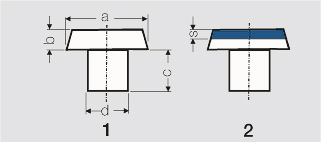General Rules for Dimensioning of Contacts
From Electrical Contacts
Revision as of 15:51, 7 April 2014 by Doduco Redaktion (talk | contribs) (→6.4.6 General Rules for Dimensioning of Contacts)
6.4.6 General Rules for Dimensioning of Contacts
- Recommended Minimum Contact Forces at Slightly Sliding Contact Make:
| Gold | 0.03 N |
| Silver | 0.1 N |
| Tungsten | 0.5 N |
- Contact Force Recommendations:
| Signal relays | ≥ 3 cN |
| AC power relays | ≥ 20 cN |
| Automotive relays | ≥ 20 cN |
| Motor switches (Contactors) (Silver – Metal oxide contacts) |
0.05 - 0.08 N/A |
| Power switches | 0.1 - 0.2 N/A |
| Connectors (Gold coating) |
≥ 30 cN/contact element |
| Connectors (Silver coating) |
≥ 50 cN/contact element |
| Connectors (Tin coating) |
≥ 1 N/contact element |
- General Rules for Dimensioning of Contact Rivets
| Dimensioning | Solid Rivets (1) | Composite Rivets (2) |
|---|---|---|
| a : d | 1.5 : 1 bis 2.5 : 1 | 2 : 1 bis 2.5 : 1 |
| a : b | 2.5 : 1 bis 10 : 1 | 3 : 1 bis 5 : 1 |
| c : b | ≥ 1 : 1 | ≥ 1 : 1 |
| b : s | ≥ 2 : 1 | |
| smin | ≈ 0.3 mm |
- Head diameter for electrical loads
| For AC currents: | approx. 1 – 1.5 A/mm² |
| For 1 A | min. 2 mm head diameter |
| 10 A | approx. 3 – 3.5 mm head diameter |
| 20 A | approx. 5 mm head diameter |
| For DC currents: | approx. 0.5 – 0.8 A/mm² |
- Head radius R for electrical loads
| for I < 1 A | R ≈ 1,5 mm |
| I = 6 A | R ≈ 5 mm |
| I = 10 A | R ≈ 10 mm |
| I = 20 A | R ≈ 15 mm |
- Failure Probability of Single and Double (Bifurcated) Contacts (according to Thielecke)
Fig. 6.18: Failure probability of a contact as a function of the voltage (according to Kirchdorfer); Ag/Ni10; 10 mA
Fig. 6.19: Failure probability of a contact as a function of the current (according to Kirchdorfer); Ag/Ni10; F = 0.45 N; U = 24 V


